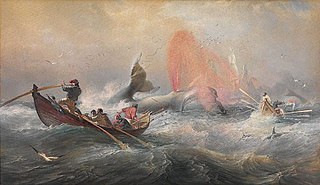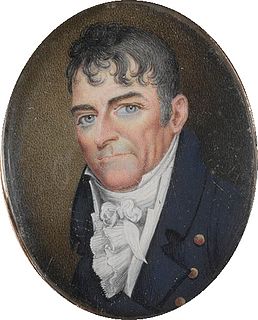
Whaling in Australian waters began in 1791 when five of the 11 ships in the Third Fleet after landing their passengers and freight at Sydney Cove then left Port Jackson to engage in whaling and seal hunting off the coast of Australia and New Zealand. The two main species hunted by such vessels in the early years were right and sperm whales. Later, humpback, bowhead and other whale species would be taken.

Britannia was a 301 burthen ton full-rigged whaler built in 1783 in Bridport, England, and owned by the whaling firm Samuel Enderby & Sons. She also performed two voyages transporting convicts to Port Jackson. She was wrecked in 1806 off the coast of New South Wales.
Samuel Enderby & Sons was a whaling and sealing company based in London, England, founded circa 1775 by Samuel Enderby (1717–1797). The company was significant in the history of whaling in the United Kingdom, not least for encouraging their captains to combine exploration with their business activities, and sponsored several of the earliest expeditions to the subantarctic, Southern Ocean and Antarctica itself.
Charles Enderby (1798–1876) was one of three sons of Samuel Enderby Junior (1756–1829). He was the grandson of Samuel Enderby (1717–1797), who founded the Samuel Enderby & Sons company in 1775. Samuel Enderby & Sons was one of the most prominent English sealing and whaling firms, active in both the Arctic and Southern Oceans. Charles and his two brothers, Henry and George, inherited Samuel Enderby & Sons when their father Samuel Junior died in 1829. They moved the company headquarters in 1830 from Paul's Wharf to Great St. Helens in London.

Eber Bunker (1761–1836) was a sea captain and pastoralist, and he was born on 7 March 1761 at Plymouth, Massachusetts. He commanded one of the first vessels to go whaling and sealing off the coast of Australia. His parents were James Bunker and his wife Hannah, née Shurtleff.

HMS Charybdis was a Royal Navy Cruizer-class brig-sloop built by Mark Richards and John Davidson at Hythe, and launched in 1809. She captured two American prizes during the War of 1812 before she was laid up in 1815 and sold in 1819. She apparently then became the whaler Greenwich, which made three voyages for Samuel Enderby & Sons and one for Daniel Bennett & Son. She was wrecked in the Seychelles in 1833 on her fourth whaling voyage.
William was a merchant vessel built in France in 1770 or 1771. From 1791 she made numerous voyages as a whaler. She also made one voyage in 1793 transporting supplies from England to Australia. She then resumed whaling, continuing until 1809.
Speedy was a whaler launched on the Thames in 1779. She also made voyages to New South Wales, transporting female convicts in 1799. She made two voyages transporting slaves in 1805 and 1806, and was captured in January 1807 on her way into London after having delivered her slaves to Antigua in 1806.
A number of sailing ships have been named Ocean.
Rockingham was launched in America in 1767 as Almsbury. By 1768 Samuel Enderby & Sons were her owners and her name was Rockingham. From 1775 Enderbys were using her as a whaler, and she made eight whaling voyages for them under that name. In 1782 Enderbys renamed her Swift, and as Swift she then performed ten whaling voyages on the Brazil Banks and off Africa until through 1793. She was still listed in Lloyd's Register as whaling until 1795.
Georgiana was built in Mexico in 1800, captured in 1801, and became a whaler for Samuel Enderby & Sons. She made three whale fishing voyages for them. She then became a merchantman, trading with Curaçao, and later, Argentina. She was last listed in 1821.
Cumberland was launched in 1800 and sailed as a West Indiaman until 1807 or 1808 when she was sold to Enderbys. She then made five voyages as a South Seas whaler. Enderbys sold Cumberland and she proceeded to sail between England and Australia. In 1827 she sailed from Hobart and was never seen again. It later transpired that pirates had captured her off the Falkland Islands and killed her crew and passengers.

Commercial whaling in Britain began late in the 16th century and continued after the 1801 formation of the United Kingdom and intermittently until the middle of the 20th century.
Rambler was launched in America in 1812. The British captured her in 1813 as she was returning to America from Manila. She then briefly became a West Indiaman. In 1815 she became a whaler in the Southern Fishery. She made four complete whaling voyages and was wrecked on her fifth.
Lucy Ann(e) was built in Canada early in the 19th century and was brought to Australia in 1827. She was first employed as a trading vessel before purchase by the New South Wales government in 1828. In government service the ship was used to help establish a number of new coastal settlements. She was also used to transport descendants of the Bounty mutineers from Pitcairn Island to Tahiti in 1830.
Sarah was launched at Hartlepool in 1800. Between 1807 and 1813 Sarah made two voyages as a whaler. As she was coming home from her first whaling voyage a French privateer captured her, but a British privateer recaptured her. After her whaling voyages Sarah became a transport, a West Indiaman, and traded with North America. She was last listed in 1826.
Sir Andrew Hammond was launched at Bermuda in 1800. She spent almost a dozen years as a West Indiaman. From 1812 on she was a whaler. On her first whaling voyage she sailed to the Pacific where the United States Navy captured her. She then served briefly in the United States Navy before the British Royal Navy recaptured her. She returned to whaling and made a further eight whaling voyages. She was lost in 1841 on her tenth whaling voyage.
Otter was launched in America in 1799. She appeared in the Register of Shipping in 1809, after she had already made the first of three voyages as a whaler. She then started trading with the Mediterranean where the French captured her in 1813.
Concord was launched at Dartmouth in 1807. From then until 1809 she traded widely. Between 1809 and 1812 two different histories emerged. The registers carried her as trading with North America. Other sources, however, have her sailing to the British Southern Whale Fishery as a sealer or whaler. She made three voyages between 1809 and 1816 in this capacity and then returned to trading. She was wrecked at the Cape of Good Hope in November 1816.
Greenwich was launched on the Thames in 1800. Between 1800 and 1813 Samuel Enderby & Sons employed her as a whaler in the British Southern Whale Fishery, and she made four whaling voyages for them. In 1813 the United States Navy captured her in the Pacific and for about a year she served there as USS Greenwich. Her captors scuttled her in 1814.






